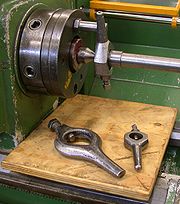
Lathe carrier
Encyclopedia


A carrier is most often used when turning between centers
Lathe center
A lathe center, often shortened to center, is a tool that has been ground to a point as to accurately position a workpiece about an axis...
on a lathe, but it may be used on dividing heads or any similar situation. It is used in conjunction with a drive plate and drive pins: the plate is mounted directly on the machine spindle (as with a chuck) and the drive pin is attached to the plate. In use the carrier and workpiece are inserted between centers and the leg of the carrier rests against the drive pin.
Carriers may be of the straight leg or bent leg type. The straight leg requires the drive pin, the bent leg fits into a slot machined into the drive plate. The bent leg type is considered safer as there are (slightly) fewer protruding parts to cause accidents.
Spindle speed
Revolutions per minute
Revolutions per minute is a measure of the frequency of a rotation. It annotates the number of full rotations completed in one minute around a fixed axis...
s are reduced when working with carriers, due to the unbalanced nature of the setup. Care must also be taken by the operator when using carriers, as it is easy to get snagged on one.

